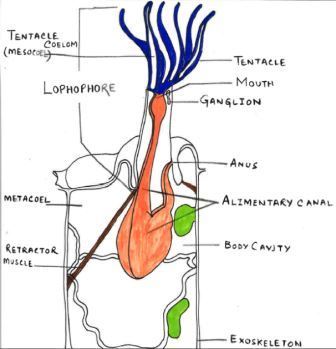Kingdom: Animalia,
Class: Lophophorata,
Phylum: Bryozoa
Bryozoa(Polyzoa/ Ectoprocta/ moss animals) are filter feeders that sieve food particles out of the water using a retractable lophophore, a "crown" of tentacles lined with cilia. Bryozoan colonies are called zooids.
Bryozoans have two types of feeding apparatus.Those apparatus plays a very important role in feeding mechanism of bryozoa.
- External
- Internal
- External:-
- Lophophore:- The Lophophore is a circular fold of body wall that encircles the mouth and consists of a basal ridge continuous with a row of ciliated tentacles.
- Tentacles with cilia:-
- The numbers of tentacles varies in different species from 8 to 34.
- The tentacles are hollow, containing a coelomic lumen continuous with a ring coelom in the lophophora base.
- Each tentacle is roughly rectangular or triangular in section.
- The outer surface and tentacular tips are devoid of cilia and provided with the projecting tactile hairs of neurosecretory cells.
- The cilia occurs as a pair of longitudinal tracts.
- The median cilia lack the power of motility according to some authors.
- The tentacles are independently movable by way of longitudinal muscles fibres, situated along the inner and outerside, just beneath the peritoneum.
- Shorter frontal cilia are present within the inner side of tentacles.
- Internal:-
Alimentary system:-- The digestive tract(‘U’ shaped) starts from the mouth and ends to anus, which are placed outside the circle of tentacle.
- The mouth is a simple round opening encircled by the lophophora base.
- The mouth is closable with circular fibres and may also be provided with radial fibres.
- The mouth leads into a wide chamber.

- 272 reads
